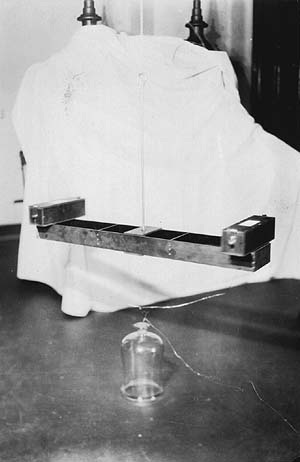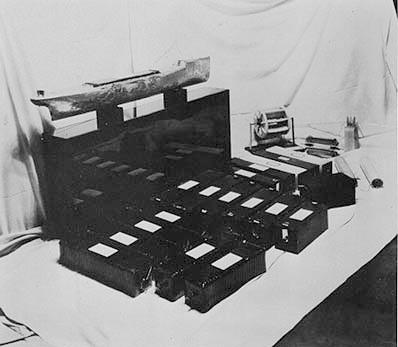The objective is to experiment with T.T. Brown (Thomas Townsend Brown) gravitators. T.T. Brown's gravitators were basically rectangular blocks of dielectric with an electrode embedded in either end and with additional metal plates embedded and evenly spaced apart throughout the length of the dielectric. In his patent 300,311 (Great Britain, Nov. 15, 1928), T.T. Brown says "This invention relates to a method of controlling gravitation and for deriving power therefrom, and to a method of producing linear force or motion. The method is fundamentally electrical." Further he says "The invention also relates to machines or apparatus requiring electrical energy that control or influence the gravitational field or the energy of gravitation".
My gravitator mark 1 (see below) showed a hint of producing motion, or at least of dampening the swinging motion when being tested, though the mark 2 version did not. It took a trememdous amount of work to make these things and so I have not made another one this way since.
About Gravitators
The following links explain how gravitators are built.
- T.T. Brown's 1928 Gravitator UK patent 300,311
- How I Control Gravitation - Article by T.T. Brown on his gravitators
|
Some of T.T. Brown's actual gravitators | |||
|
| ||
Note that in the above left photo you can see bare wires in use. This is the most common mistake experimenters make and should never be done if you are looking for a non-ion related source of thrust. See these Poynting flow thruster experiments for a good demonstration of just how hard you have to work to eliminate bare wires as a source of thrust.
Devices and Experiments
Here are the more relevant devices and experiments I have done so far:
Links
-
Cellular Gravitation - Gravitator experiments of James Batchelor
BUT, be sure to also read this correspondance between myself and James Batchelor too. It indicates, in my opinion, that the source of the movement may have been ionization at the feed wires. - Ice Capacitor and Polysulfide Experiments - Also by James Batchelor




